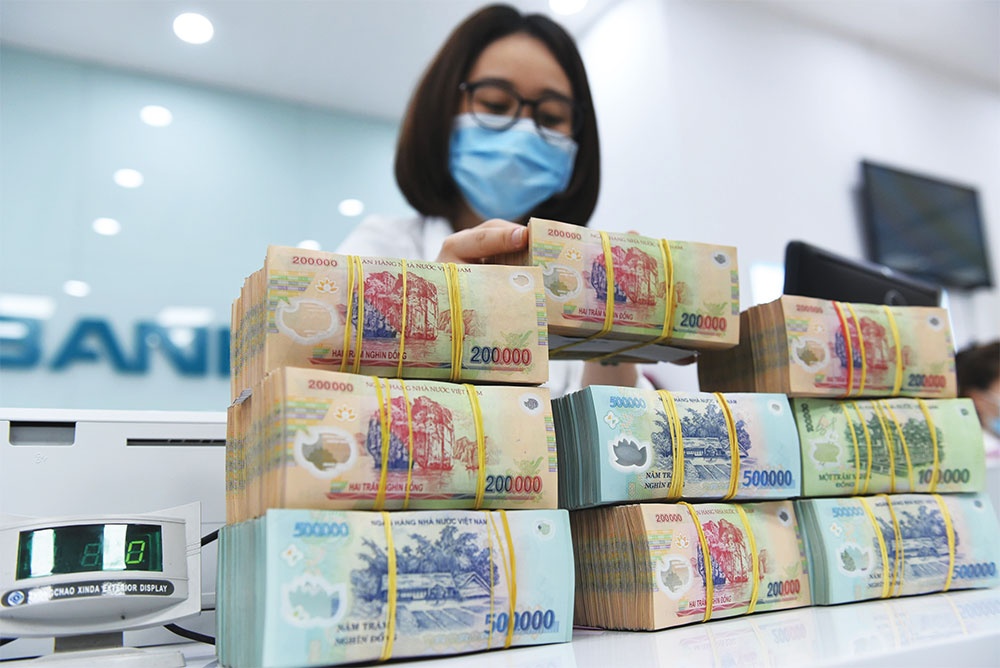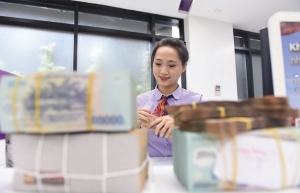Lenders manifest steady trajectory with profit figures
The first bank to publish its financial statements in Vietnam was PGBank, which recorded a Q1 pre-tax profit at VND153 billion ($6.5 million), up 21 per cent over the same period. As of March 31, 2023, PGBank’s total assets were down 5 per cent compared to the beginning of the year, mainly due to the bank’s reduction in lending to other credit institutions and a decrease in its investment securities portfolio.
Outstanding loans to customers increased by 0.3 per cent, while customer deposits expanded by 4.8 per cent.
 |
| There was an improvement in banking business in Q1, but the improvement rate has slowed compared to the previous quarter, Photo: Dung Minh |
According to PGBank’s financial report, its net interest income increased by 44.5 per cent compared to the first quarter of 2022, mainly thanks to the growth of interest income from customer loans. Moreover, profit from services increased by 32 per cent, and profit from foreign exchange rose by 32.4 per cent.
Meanwhile, investment in securities trading did not record any profit/loss in the first quarter.
According to Nguyen Duc Vinh, general director of VPBank, by the end of March, the bank achieved more than VND4 trillion ($170.16 million) in profit, with credit growth of 7 per cent and deposit growth of 11.5 per cent.
While profit figures are still near the top, VPBank has only reached about 20 per cent of the plan for the first quarter of 2023. Meanwhile, subsidiary FE Credit continues to suffer losses.
“VPBank has two strategic segments, small- and medium-sized enterprises and retail, which are still growing despite challenges. The bank plans to shift its focus to medium and large enterprises and also plans to expand its services to foreign-invested enterprises,” Vinh explained.
“We will introduce technology platforms to support individual customers and develop digital banking to attract more customers. Additionally, the bank’s securities company is expected to contribute significantly to profits after recent capital increases,” he added.
Elsewhere, Eximbank’s general director Tran Tan Loc informed that the bank’s pre-tax profit was estimated at over VND900 billion ($38.3 million), up 16 per cent over the same period last year.
Tu Tien Phat, general director of ACB, said the consolidated Q1 profit reached VND5.1 trillion ($217 million), up 24 per cent over the same period and reaching 26 per cent of the full-year plan.
Phat said that despite being affected by the economic slowdown, the bank’s management is confident of completing the annual plan, along with appropriate credit and deposit growth.
“Credit growth has shown signs of recovery since March, which has helped the bank complete 26 per cent of the profit plan. This is an encouraging result for a retail bank,” Phat said.
In the same vein, SHB’s general director informed that the bank’s pre-tax profit in Q1 reached more than VND3.5 trillion ($149 million), up about 10.3 per cent over the same period in 2022. With this result, SHB completed about 35 per cent of its profit target for the year.
Explaining where the Q1 profit results came from, the general director of SHB said, “SHB continued to promote its retail strategy and increase service revenue. The digital transformation strategy is promoting efficiency and helping to optimise operations.”
It was reported that groups involved in almost one-quarter of the total capitalisation value of Vietnam’s stock exchanges have estimated or officially announced their profits for Q1.
According to FiinTrade, profit after tax Q of 10 banks representing 70 per cent of banking industry capitalisation was estimated to have increased by 14 per cent over the same period the previous year. Notably, the profit after tax of 10 banks increased by 17.8 per cent compared to the previous quarter.
FiinTrade added that profit growth from the group of state-owned banks was supported by increased credit and sustained net interest margins. As for BIDV, the reduced provisioning pressure also helped the bank improve its profit in the first quarter.
For joint-stock banks, with the exception of those with a high proportion of loans to the real estate sector (including TCB) whose profits decreased due to the increase in provision for credit risks, most of them made profits. Q1’s profit after tax is estimated to grow over the same period, led by STB (+57 per cent) and ACB (+24.6 per cent). However, credit growth has been very low or even decreased in some retail banks (including ACB and VIB).
On the stock market, the prices of banks with high profits in the first quarter, including BID, ACB, and STB, are now at a peak after one year – a strong recovery by 40-60 per cent compared to the middle of November last year.
According to survey results from the Department of Forecasting and Statistics at the State Bank of Vietnam, there was an improvement in the business situation of the banking system in Q1, but the improvement rate has slowed compared to the previous quarter. Credit institutions assessed that the pre-tax profit of the banking system has grown in Q1 but not as much as expected.
However, 67-80 per cent of credit institutions expect their business to improve in the second quarter and the whole of 2023. Nearly 90 per cent of them expect profits in 2023 to grow positively compared to 2022. Furthermore, 5.7 per cent are still worried about negative profit growth in 2023 and 5.7 per cent of credit institutions estimated unchanged profit.
The survey report added that demand in the economy for banking products and services, together with customer’s business and financial conditions, are expected to be the most important objective factors to help improve the banking sector situation for the remainder of the year.
 | Lenders elevate charter capital moves There have been positive signals of increased charter capital activities at commercial banks in recent weeks, especially those with state capital. |
 | Stable lenders to lead to interest in stocks Identifying the risk factors of the banking system can open up prospects to invest in banking stocks this year, industry experts are saying, while banks themselves are urged to take provisioning activities into consideration. |
 | Banks expanding share over borders Several Vietnamese lenders are tapping into other dynamic economies and aiding Vietnamese enterprises operating in cross-border trading activities. |
 | Lenders must embrace responsibility to real estate The banking system is under pressure to assist the real estate market through recent turbulence. Dr. Le Xuan Nghia, member of the National Financial and Monetary Policy Advisory Council, talked with VIR’s Hong Dung about the situation and projections for what is to come. |
What the stars mean:
★ Poor ★ ★ Promising ★★★ Good ★★★★ Very good ★★★★★ Exceptional
Related Contents
Latest News
More News
- Tax sector wraps up 2025 and sets priorities for next year (December 25, 2025 | 14:00)
- A tipping point for digital and hybrid wealth management in Vietnam (December 23, 2025 | 13:33)
- $250 million deal targets women-owned SMEs, sustainable agriculture (December 22, 2025 | 17:40)
- Stock market posts resilient 2025 performance (December 19, 2025 | 18:17)
- Citi Vietnam receives 2025 AmCham CSR recognition (December 19, 2025 | 16:35)
- As global green supply chain reshapes, will Vietnam be left behind? (December 19, 2025 | 08:00)
- Banks gear up for massive capital increases (December 18, 2025 | 17:04)
- Securing capital and efficiency for Vietnam’s 2026-2030 growth ambitions (December 17, 2025 | 10:00)
- Energy sector in need of blended finance mechanisms (December 17, 2025 | 09:00)
- Vietnam still has room to mobilise capital for sustainable growth (December 17, 2025 | 08:57)

 Tag:
Tag:




















 Mobile Version
Mobile Version